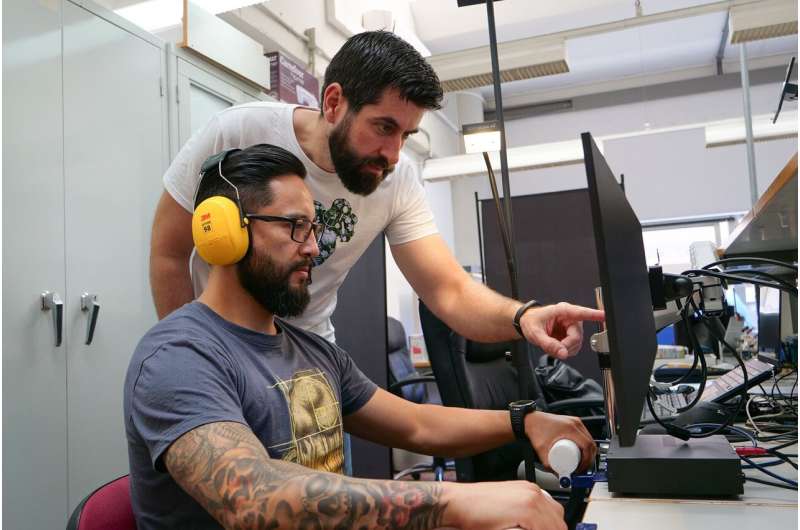Scientists modify the configuration parameters of ‘phantom sensations’ so that people can perceive them
Can people feel through the sense of touch in the absence of a real tactile stimulation? In other words, can we feel the sensation of being touched when in reality we are not? This is what is known as “phantom sensation,” which occurs when the nervous system perceives a tactile illusion that does not correspond to an authentic physical stimulus, that is, it does not exist.
The term, according to researchers from the group “Electronics for Instrumentation and Systems” of the UMA, appeared a few decades ago. However, thanks to their work, it has been possible to determine, for the first time, the minimum distance a vibrating point must travel for this moving phantom sensation to be perceived. The results of this research have been published in the journal Displays.
One of the authors of this research, the Professor of the Department of Electronics Andrés Trujillo, points out that the illusion of motion occurs when we place two vibrating devices—known as vibrotactile actuators—in two different locations on the skin.
“With proper stimulation, an individual, instead of perceiving two isolated vibrations, can experience the feeling that there is a vibrating point moving between these two devices, although this point does not really exist, it is illusory,” he explains.
According to this engineer, thanks to the experiments carried out at the UMA, they have managed to modify the configuration parameters of the “phantom sensation” that have been used until now. “We have developed an instruction manual to know the operating limits of this tactile illusion,” explains Trujillo.
Thus, the engineers of the University of Malaga have established that, on average, individuals are able to perceive the illusion of phantom motion of an illusory vibrating point when the traveled distance is at least 20% of the separation between the actuators.
[embedded content]
Potential applications
Implementing tactile illusions in virtual or augmented reality is one of its potential applications, the main advantage being that its use would allow to create moving sensations only with a couple of actuators.
“The conventional application would be to place a series of actuators, not just two, and systematically switch them on and off to create the feeling of movement,” says Trujillo, adding that, therefore, this finding translates into the development of cost-effective, lighter and higher resolution devices.
Its use in haptic vests, video games, touch screens for blind people or concerts, for example, are other applications of these phantom or apparent motion, which provides users with realism and new sensations.
The scientific paper “Phantom sensation: Threshold and quality indicators of a tactile illusion of motion,” is the result of the doctoral thesis of researcher Paul Byron Remache-Vinueza, directed by the Professor of the School of Industrial Engineering Fernando Vidal and Andrés Trujillo, that advances in the purpose of transmitting musical sensations through the skin for people with hearing impairment.
More information:
Byron Remache-Vinueza et al, Phantom sensation: Threshold and quality indicators of a tactile illusion of motion, Displays (2024). DOI: 10.1016/j.displa.2024.102676
University of Malaga
Citation:
Scientists modify the configuration parameters of ‘phantom sensations’ so that people can perceive them (2024, May 29)
retrieved 30 May 2024
from https://techxplore.com/news/2024-05-scientists-configuration-parameters-phantom-sensations.html
This document is subject to copyright. Apart from any fair dealing for the purpose of private study or research, no
part may be reproduced without the written permission. The content is provided for information purposes only.

Comments are closed